Cast Your C7 Corvette Vote!
![]() Loading ...
Loading ...
ZR1 Corvette Chassis Display:
Corvette Chassis Engineering At Its Best!
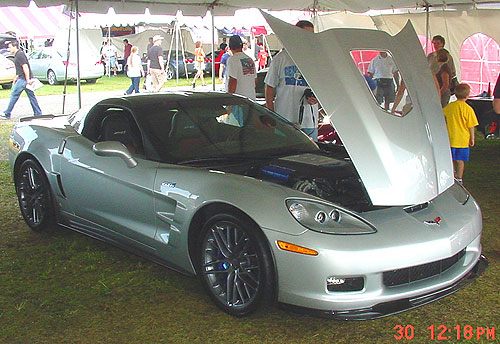
An off-the-showroom-floor ‘09 or ‘10 ZR1 Corvette could walk away from most of the Corvette racers on display by 20 to 70 mph… with the air conditioner and stereo on!
I don’t believe that it’s possible to look at an ‘09 or ‘10 ZR1 Corvette and yawn. There’s a lot of chatter in the blogosphere about certain Asian and European cars that can “kick the ZR1’s butt!” Whatever! I’ve noticed that cars in the “supercar” realm now have a minimum of at least 600-horsepower. This is NUTS for a street car, but it’s fun to watch. Actual performance depends on where the car is being driven and how big your kahonies are. Since the theme of the ‘09 Corvettes at Carlisle was Corvette race cars, it was interesting to me to see so many of those magnificent old Corvette war horses. My interest in the Corvette hobby goes back to the heady days of the big-block Vettes with cars such as the nearly unstreetable L-88s and the dreamy all-aluminum 427 ZL-1. It was a magical notion of having a Corvette with big-block horsepower and torque, with less weight than a cast-iron small-block Chevy engine. An off-the-showroom-floor ‘09 or ‘10 ZR1 Corvette could walk away from most of the Corvette racers on display by 20 to 70 mph… with the air conditioner and stereo on!
The Thrill is Back.
Okay, enough gushing. Much has happened in Corvetteland since December ‘07 when GM took the wraps off the ZR1. We had the ‘08 Z06 427 Special and the ‘08 Pace Car Special come out. And this year the ‘10 Grand Sport was unleashed. Just a word about the Grand Sport. I think this is arguably the nicest-looking package Corvette ever offered. With availability of all colors and lots of trim variations, the possibilities are tremendous. Granted, a Z06 will smoke a GS, but on the street, 437-horsepower is all the car 99% of most Corvette owners will ever need. If someone isn’t used to strong acceleration, a “believer’s ride” in a new stock Corvette could be a frightening experience.
Back to the ZR1. We’ve been treated to lots of exciting product from Chevrolet since 12-08 and I think to many Corvette enthusiasts, the ZR1 is moving into the “seen it” arena. Aside from the peek-a-boo hood, unique fender vents, special wheels, and carbon fiber roof and rocker panels… it looks like a Corvette. Like that old B.B. King song… “The Thrill Is Gone.” So when attendees went into the GM Engineer’s tent, they were in for a unique surprise.
When the ZR1 made it’s debut in December ‘08, GM created a very cool display for the chassis.
Chevrolet made a special stand that held the entire chassis straight up so you could see it from the top, sides, and bottom. A top and bottom view is pretty unusual, but then again, for a production car made by a major auto manufacturer, this is a VERY special chassis. The thrill is back.
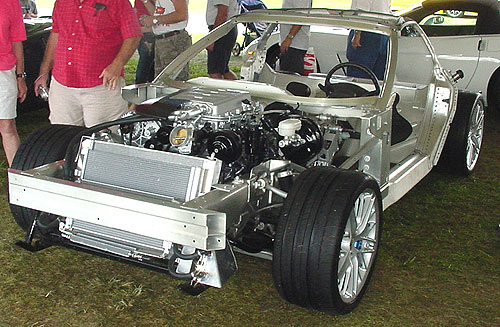
Chassis ZR1: Art in Aluminum, Magnesium & Carbon Fiber.
Aside from the windshield frame, it’s hard to tell what kind of car this is. Unlike Corvettes of old, aside for fasteners and a few other parts, there’s almost no steel on this car – almost everything is either aluminum, titanium, magnesium, carbon fiber, plastic, and balsa wood. Yes, “balsa wood,” we’ll get to that later. When looking at this chassis, it’s worth keeping in mind that while certain design aspects might not seem very exotic, this is a supercar that is built to be mass produced and pass the rigors of safety crash testing and durability challenges, as well as being capable of race car-like high-speed performance. Yet, the car is designed to be docile enough to be an everyday driver… with 638-horsepower and 604 ft-lbs or torque!
I
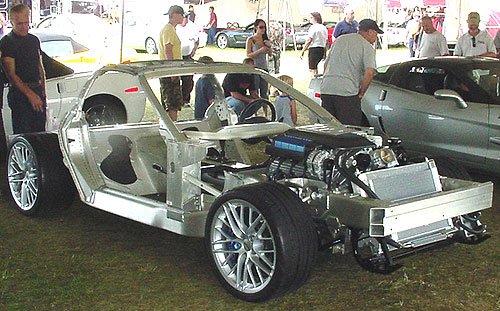
Unlike race cars, the ZR1 complies with federal front and rear crash regulations.
When you look at the chassis of the ZR1 what you’re seeing is a design that functions just like a tub-frame racing chassis, but with hydroformed frame rails and aluminum support members. And unlike race cars, the ZR1 complies with federal front and rear crash regulations. Note how the B-pillar forms a roll bar. This has been a design feature on Corvette coupes since the first ‘63 Corvette coupe.
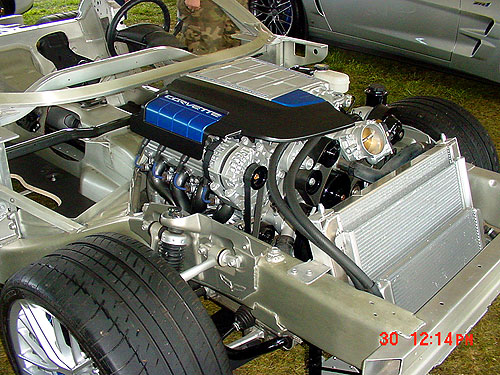
Remember when cars had only one radiator?
Remember when cars had only one radiator? What looks like 3 radiators is actually a water radiator, oil cooler, and power steering cooler. The front tires are the widest, and the wheels are largest wheel diameter ever offered on a production Corvette – Speedline 10.0-by 19-inch wearing Michelin PS2 tires measuring 285/30. Hidden behind the front wheels are a Brembo carbon-ceramic brake system with 15.5 by 1.6 vented and cross-drilled rotors with 6-piston calipers. The upper and lower wishbone control arms are made from aluminum and you can see just a small portion of the ZR1’s composite transverse front monospring. No coil springs here. The lightweight mono-leaf spring gets the job done.
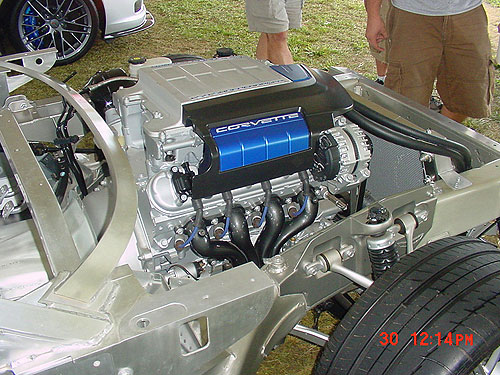
So where’s the blower?
To create a 638-horsepower LS9 ZR1 engine, Chevrolet designers started with a production LS3 block. Yes, the base engine’s block and basic structure is that good. “So where’s the blower?” you ask.
The Eaton R1900 supercharger with 10.5-psi boost is tucked inside the engine, in the lifter valley, underneath of the Behr intercooler that sits on top of the engine. And check out those factory tube headers, as good as anything on the aftermarket and will last a very long time. Catalytic converters are mounted just after the headers. The exhaust pipes have a crossover located just aft of the catalytic converters. A massive “torque tube” ties the LS9 engine with the transaxle, keeping the front and back of the drive train functioning together.
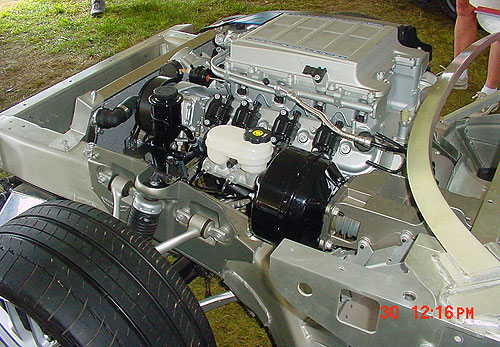
Corvette engineer, Gib Hufstader shares a tidbit.
While the LS9 engine is mostly aluminum, I learned an interesting tidbit in Spring ‘09 in a conversation with former Corvette engineer, Gib Hufstader. The idea of an all-aluminum engine in a Corvette goes all the way back to the ‘57 Q-Corvette concept car. The plan was for all Chevy cars to be using a transaxle by the model year 1960! The Corvette version was to have an all-aluminum engine, a transaxle, 4-wheel disc brakes, 4-wheel independent suspension, a dry-sump oil system, and a host of other goodies that sound a lot like the C5 and C6 Corvette. The “all-aluminum engine” finally arrived in ‘69 in the form of the 427 ZL-1 big-block. But Hufstader told me that they were working on an even LIGHTER engine, with a magnesium block! How cool is that!? While the ZR1’s LS9 engine is “just” made from aluminum, the engine cradle and rear subframe are magnesium. Anyone interested in a magnesium 427 engine for the ZR1 in 2011? (don’t hold your breath on that one)
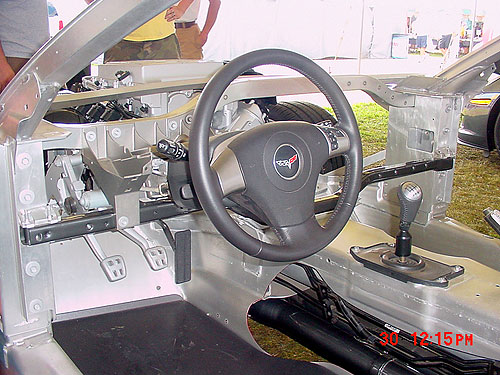
A better looking Corvette steering wheel?
Obviously, the real car doesn’t have a big hole on the left side of the transmission tunnel. Here we can see the extensive windshield cowl bracing. While I don’t personally have a beef with the Corvette’s steering wheel, LOTS of road testers LOVE to bitch about the Malibu, er, ah, Corvette steering wheel. Steering wheels are no longer just a wheel on a steering shaft like the old C1 to C3 cars, they perform functions undreamed of in the early days. Plus, there’s an airbag in there too. Either way, I wish Chevrolet would come up with a better-looking, dedicated steering wheel for the Corvette, so road testers can stop complaining. Actually, one of the few things I hope to see before the C6 is retired would be an interior upgrade/redesign.
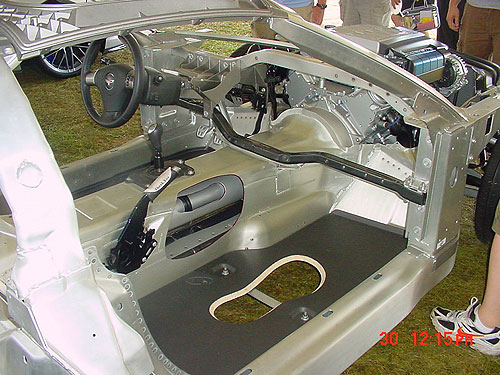
Here we can see the extensive bracing for the rear suspension towers.
Shown here is the Fred Flintstone emergency passenger braking system. (just KIDDING!) Actually, this shot shows the balsa wood-aluminum composite floorboards. This isn’t a cheaped-out solution. Balsa wood happens to be extremely lightweight, and is an excellent sound deadener and heat insulator. Magnesium shows up again in the roof section. The material is actually injection-molded, just like plastic, allowing for complex, super lightweight parts to be created. The roof section has a ribbed honeycomb design to improve stiffness and light weight at the top of the car’s structure. These inner design features and the carbon fiber roof skin help give the ZR1 the lowest center of gravity of any production Corvette ever built.
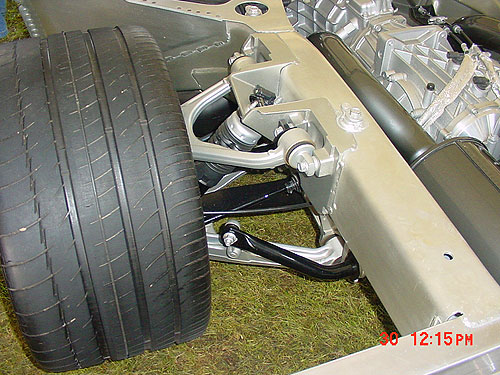
“Nothing” like the leaf springs on your old Chevy Nova.
Here’s the ZR1’s rear suspension – aluminum double wishbone and massive rear tires. Shweet! The Speedline forged aluminum-alloy wheels measure 12.0 x 20-inches and wear Michelin PS2 335/25 tires. These tires are almost THREE TIMES the size of the tires used on the old C1 Corvette race cars on display at this year’s Corvettes at Carlisle show! Coil spring-over shocks look very cool, but the ZR1 uses a transverse composite leaf spring. But don’t dismay, this isn’t anything like the leaf springs on your old Chevy Nova.
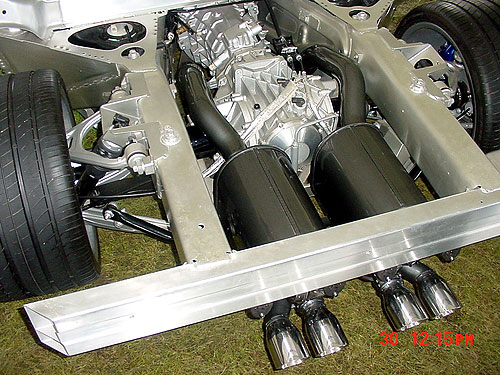
Massive stainless steel mufflers
The ZR1 sports a set of massive stainless steel mufflers with bypass valves manufactured by Pierberg. Note the large anti-roll bar between the chassis rail and the inside rear tire. The large aluminum transverse beam holds the crash bumper system.
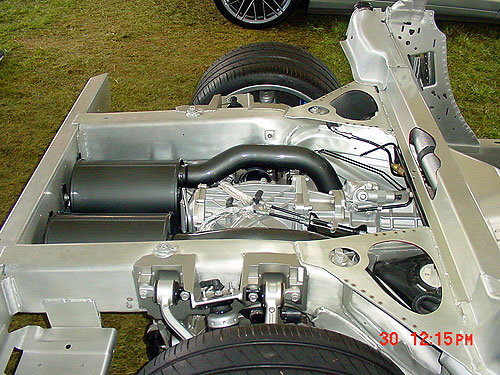
Where are the gas tanks?
Doesn’t it look like something’s missing? Like a gas tank? The ZR1 has two gas tanks, located just ahead of the rear axle centerline. There’s a transfer system that allows for the use of a single filler neck.
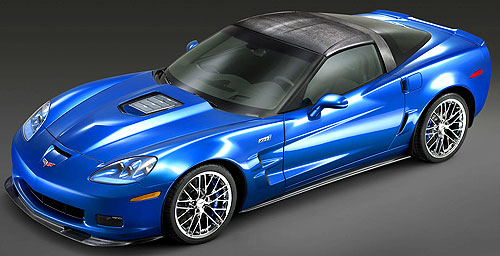
The ZR1 Wishlist..
So, is there anything I DON’T like about the C6 ZR1. Well, anything can be improved, I suppose. Considering that this is a mass-produced automobile that has passed all of the durability, crash, and fuel standards, AND has a governor on it set to 210-mph, are you really going to let that steering wheel distract you? (Watch the road!) I think I could get used to it, how about you?
What would I put on my ZR1 Wish-List? Here goes…
1. A for-real 427, or better yet, 454 engine. I know all about the limitations of the Z06’s LS7 block with a supercharger, blah, blah, blah. So design a new block, and while you’re at it, make it out of magnesium, thank you.
2. “All-Wheel-Drive” anyone? After all, if they could squeeze, say, 700-horsepower out of a 427 or 454 engine, you would definitely need all-wheel-drive. And probably wider tires too. And then they’ll have to puff those rear fenders out some more. Might as well make them out of carbon fiber too. “Power to the ground!” as the drag racers like to say.
3. This is really picky, but the rear spoiler looks just a tad anemic to me. I know it’s been wind tunnel-tested, but another 2-inches in height would match the front air-splitter. (When did “spoilers” become “air-splitters?)
4. Let’s get an all-new interior so that the snipers will once and for all SHUT UP! After all, if you’re going to spend $105,000-plus for a Corvette, what’s another $10,000 to $15,000 for a super interior?
It’s kind of funny, but when the ZR1 was first shown and the car’s specs were released, there was some grumping about the car’s weight. It weighs around 150-pounds or so more than a Z06. But with 133 more horsepower than a Z06 and 201 more horsepower than a stock Corvette, does 150-pounds matter? On a race track, yes. On the street, no. That extra weight grumbling fell away after testers got to drive the car. OH WOW!
Here’s approximately where the ZR1 falls in the performance department:
0-60-mph: 3.5-seconds
1/4-mile: 11.0-seconds
Top-speed: 200-plus mph
This is a Corvette that will be talked about for many, many years. I covered the basic car in my VETTE Magazine column, “The Illustrated Corvette Series No. 133” in the August 2008 issue and the ZR1 engine in “The Illustrated Corvette Series No. 134” in the September issue. You can see the artwork and read the stories here…
Illustrated Corvette Series Link
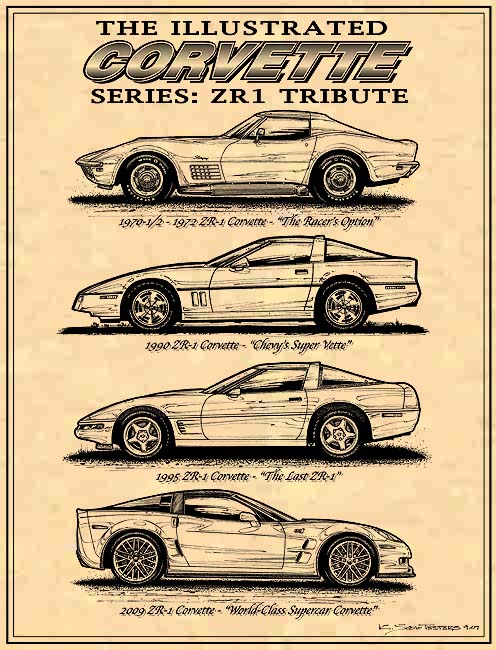
That’s all for now. Save the Wave! – Scott
Links of Interest:
VetteTube ZR1 Build Process Plant Video
Sam Winegarden GM Engine Guru Interview
Enjoy all of Scott’s Corvette Artwork and Articles Here
Go here for the 2009 Corvettes at Carlisle Racer Theme Review Post
Autoblog has a full report on the ZR1 chassis display… AutoBlog Link.

A pal urged me to look at this site, great post, fanstatic read… keep up the cool work!
Thank you very much. I had read all about the ZR1’s unique frame and
chassis, but seeing it in person with that beautiful display piece at
Carlisle last August really drove it home for me. We got to see how to build
a world-class supercar, mass production style. As an artist, I saw it as
“automotive art.” I could have stayed there much longer, but there was so
many other cools Corvettes to see.
By the way, we’re working on a book version of The Illustrated Corvette
Series, published by CarTech Books. The release date in mid-’10. And scoop
up a copy of our free Corvette Engine Spotters Guide. Look for the link at
the to psidebar of the blog. Happy Holidays and Save the Wave! – Scott